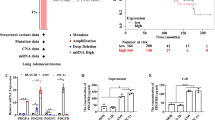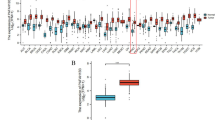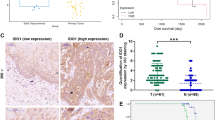Abstract
Esophageal squamous cell carcinoma (ESCC) is one of the most common malignancies worldwide and occurs at a relatively high frequency in China, yet the mechanisms underlying its devastating outcome remain unclear. Here we report that platelet-activating factor receptor (PAFR), a type of G-protein-coupled receptor, was upregulated in ESCC tumors and cell lines, compared with controls; PAFR levels were positively correlated with ESCC clinical stages and survival time. Overexpression of PAFR promoted the malignant development of ESCC in vitro and in vivo, whereas depletion of PAFR suppressed these effects. Interestingly, PAFR was observed to activate PI3K/AKT (phosphatidylinositol 3-kinase/AKT) through the upregulation of FAK kinase activity. AKT-triggered nuclear factor-κB transcriptionally activated PAFR expression. This mutual positive regulation between PAFR and AKT was required for the aggressiveness of ESCC cells both in vitro and in vivo. Furthermore, treating mice bearing ESCC tumors with cholesterol-conjugated PAFR small interfering RNA effectively inhibited tumor progression and the expression of AKT-mediated oncogenic proteins. Taken together, we made the first demonstration that dysregulation of PAFR and the positive regulatory loop between PAFR and pAKT contribute to malignant progression of ESCC.
This is a preview of subscription content, access via your institution
Access options
Subscribe to this journal
Receive 50 print issues and online access
$259.00 per year
only $5.18 per issue
Buy this article
- Purchase on Springer Link
- Instant access to full article PDF
Prices may be subject to local taxes which are calculated during checkout










Similar content being viewed by others
References
Kamangar F, Dores GM, Anderson WF . Patterns of cancer incidence, mortality, and prevalence across five continents: defining priorities to reduce cancer disparities in different geographic regions of the world. J Clin Oncol 2006; 24: 2137–2150.
Dorsam RT, Gutkind JS . G-protein-coupled receptors and cancer. Nat Rev Cancer 2007; 7: 79–94.
Senga T, Iwamoto S, Yoshida T, Yokota T, Adachi K, Azuma E, Hamaguchi M, Iwamoto T . LSSIG is a novel murine leukocyte-specific GPCR that is induced by the activation of STAT3. Blood 2003; 101: 1185–1187.
Boire A, Covic L, Agarwal A, Jacques S, Sherifi S, Kuliopulos A . PAR1 is a matrix metalloprotease-1 receptor that promotes invasion and tumorigenesis of breast cancer cells. Cell 2005; 120: 303–313.
Lango MN, Dyer KF, Lui VW, Gooding WE, Gubish C, Siegfried JM, Grandis JR . Gastrin-releasing peptide receptor-mediated autocrine growth in squamous cell carcinoma of the head and neck. J Natl Cancer Inst 2002; 94: 375–383.
Keane MP, Belperio JA, Xue YY, Burdick MD, Strieter RM . Depletion of CXCR2 inhibits tumor growth and angiogenesis in a murine model of lung cancer. J Immunol 2004; 172: 2853–2860.
Lee Z, Swaby RF, Liang Y, Yu S, Liu S, Lu KH et al. Lysophosphatidic acid is a major regulator of growth-regulated oncogene alpha in ovarian cancer. Cancer Res 2006; 66: 2740–2748.
Liu X, Wu WK, Yu L, Li ZJ, Sung JJ, Zhang ST et al. Epidermal growth factor-induced esophageal cancer cell proliferation requires transactivation of beta-adrenoceptors. J Pharmacol Exp Ther 2008; 326: 69–75.
Ding Y, Shimada Y, Maeda M, Kawabe A, Kaganoi J, Komoto I et al. Association of CC chemokine receptor 7 with lymph node metastasis of esophageal squamous cell carcinoma. Clin Cancer Res 2003; 9: 3406–3412.
Sud N, Sharma R, Ray R, Chattopadhyay TK, Ralhan R . Differential expression of G-protein coupled receptor 56 in human esophageal squamous cell carcinoma. Cancer Lett 2006; 233: 265–270.
Venable ME, Zimmerman GA, McIntyre TM, Prescott SM . Platelet-activating factor: a phospholipid autacoid with diverse actions. J Lipid Res 1993; 34: 691–702.
Haribabu B, Zhelev DV, Pridgen BC, Richardson RM, Ali H, Snyderman R . Chemoattractant receptors activate distinct pathways for chemotaxis and secretion. Role of G-protein usage. J Biol Chem 1999; 274: 37087–37092.
Kato M, Kimura H, Motegi Y, Tachibana A, Minakami H, Morikawa A et al. Platelet-activating factor activates two distinct effector pathways in human eosinophils. J Immunol 2002; 169: 5252–5259.
van Biesen T, Hawes BE, Raymond JR, Luttrell LM, Koch WJ, Lefkowitz RJ . G(o)-protein alpha-subunits activate mitogen-activated protein kinase via a novel protein kinase C-dependent mechanism. J Biol Chem 1996; 271: 1266–1269.
Deo DD, Bazan NG, Hunt JD . Activation of platelet-activating factor receptor-coupled G alpha q leads to stimulation of Src and focal adhesion kinase via two separate pathways in human umbilical vein endothelial cells. J Biol Chem 2004; 279: 3497–3508.
Marques SA, Dy LC, Southall MD, Yi Q, Smietana E, Kapur R et al. The platelet-activating factor receptor activates the extracellular signal-regulated kinase mitogen-activated protein kinase and induces proliferation of epidermal cells through an epidermal growth factor-receptor-dependent pathway. J Pharmacol Exp Ther 2002; 300: 1026–1035.
Aponte M, Jiang W, Lakkis M, Li MJ, Edwards D, Albitar L et al. Activation of platelet-activating factor receptor and pleiotropic effects on tyrosine phospho-EGFR/Src/FAK/paxillin in ovarian cancer. Cancer Res 2008; 68: 5839–5848.
Cellai C, Laurenzana A, Vannucchi AM, Caporale R, Paglierani M, Di Lollo S et al. Growth inhibition and differentiation of human breast cancer cells by the PAFR antagonist WEB-2086. Br J Cancer 2006; 94: 1637–1642.
Heon Seo K, Ko HM, Kim HA, Choi JH, Jun Park S, Kim KJ et al. Platelet-activating factor induces up-regulation of antiapoptotic factors in a melanoma cell line through nuclear factor-kappaB activation. Cancer Res 2006; 66: 4681–4686.
Sahu RP, Kozman AA, Yao Y, DaSilva SC, Rezania S, Martel KC et al. Loss of the platelet activating factor receptor in mice augments PMA-induced inflammation and cutaneous chemical carcinogenesis. Carcinogenesis 2012; 33: 694–701.
Asanuma H, Torigoe T, Kamiguchi K, Hirohashi Y, Ohmura T, Hirata K et al. Survivin expression is regulated by coexpression of human epidermal growth factor receptor 2 and epidermal growth factor receptor via phosphatidylinositol 3-kinase/AKT signaling pathway in breast cancer cells. Cancer Res 2005; 65: 11018–11025.
Dulinska-Litewka J, McCubrey JA, Laidler P . Increased Akt signaling resulting from the loss of androgen responsiveness in prostate cancer. Curr Med Chem 2013; 20: 144–157.
Suzuki A, Lu J, Kusakai G, Kishimoto A, Ogura T, Esumi H . ARK5 is a tumor invasion-associated factor downstream of Akt signaling. Mol Cell Biol 2004; 24: 3526–3535.
Li J, Davidson G, Huang Y, Jiang BH, Shi X, Costa M et al. Nickel compounds act through phosphatidylinositol-3-kinase/Akt-dependent, p70(S6k)-independent pathway to induce hypoxia inducible factor transactivation and Cap43 expression in mouse epidermal Cl41 cells. Cancer Res 2004; 64: 94–101.
Zhou W, Ibe BO, Raj JU . Platelet-activating factor induces ovine fetal pulmonary venous smooth muscle cell proliferation: role of epidermal growth factor receptor transactivation. Am J Physiol Heart Circ Physiol 2007; 292: H2773–H2781.
Soldi R, Sanavio F, Aglietta M, Primo L, Defilippi P, Marchisio PC et al. Platelet-activating factor (PAF) induces the early tyrosine phosphorylation of focal adhesion kinase (p125FAK) in human endothelial cells. Oncogene 1996; 13: 515–525.
Deo DD, Axelrad TW, Robert EG, Marcheselli V, Bazan NG, Hunt JD . Phosphorylation of STAT-3 in response to basic fibroblast growth factor occurs through a mechanism involving platelet-activating factor, JAK-2, and Src in human umbilical vein endothelial cells. Evidence for a dual kinase mechanism. J Biol Chem 2002; 277: 21237–21245.
Li Y, Ma J, Guo Q, Duan F, Tang F, Zheng P et al. Overexpression of MMP-2 and MMP-9 in esophageal squamous cell carcinoma. Dis Esophagus 2009; 22: 664–667.
Rosato A, Pivetta M, Parenti A, Iaderosa GA, Zoso A, Milan G et al. Survivin in esophageal cancer: An accurate prognostic marker for squamous cell carcinoma but not adenocarcinoma. Int J Cancer 2006; 119: 1717–1722.
Tanigawa N, Matsumura M, Amaya H, Kitaoka A, Shimomatsuya T, Lu C . Tumor vascularity correlates with the prognosis of patients with esophageal squamous cell carcinoma. Cancer 1997; 79: 220–225.
Chen M, Cai E, Huang J, Yu P, Li K . Prognostic value of vascular endothelial growth factor expression in patients with esophageal cancer: a systematic review and meta-analysis. Cancer Epidemiol Biomarkers Prev 2012; 21: 1126–1134.
Mutoh H, Ishii S, Izumi T, Kato S, Shimizu T . Platelet-activating factor (PAF) positively auto-regulates the expression of human PAF receptor transcript 1 (leukocyte-type) through NF-kappa B. Biochem Biophys Res Commun 1994; 205: 1137–1142.
Engelman JA . Targeting PI3K signalling in cancer: opportunities, challenges and limitations. Nat Rev Cancer 2009; 9: 550–562.
Chen HC, Appeddu PA, Isoda H, Guan JL . Phosphorylation of tyrosine 397 in focal adhesion kinase is required for binding phosphatidylinositol 3-kinase. J Biol Chem 1996; 271: 26329–26334.
Mitra SK, Hanson DA, Schlaepfer DD . Focal adhesion kinase: in command and control of cell motility. Nat Rev Mol Cell Biol 2005; 6: 56–68.
Stokes JB, Adair SJ, Slack-Davis JK, Walters DM, Tilghman RW, Hershey ED et al. Inhibition of focal adhesion kinase by PF-562,271 inhibits the growth and metastasis of pancreatic cancer concomitant with altering the tumor microenvironment. Mol Cancer Ther 2011; 10: 2135–2145.
Quint P, Ruan M, Pederson L, Kassem M, Westendorf JJ, Khosla S et al. Sphingosine 1-phosphate (S1P) receptors 1 and 2 coordinately induce mesenchymal cell migration through S1P activation of complementary kinase pathways. J Biol Chem 2013; 288: 5398–5406.
Walsh CT, Stupack D, Brown JH . G protein-coupled receptors go extracellular: RhoA integrates the integrins. Mol Interv 2008; 8: 165–173.
Rozengurt E . Mitogenic signaling pathways induced by G protein-coupled receptors. J Cell Physiol 2007; 213: 589–602.
Gibbs TC, Rubio MV, Zhang Z, Xie Y, Kipp KR, Meier KE . Signal transduction responses to lysophosphatidic acid and sphingosine 1-phosphate in human prostate cancer cells. Prostate 2009; 69: 1493–1506.
Wang D, Sadee W, Quillan JM . Calmodulin binding to G protein-coupling domain of opioid receptors. J Biol Chem 1999; 274: 22081–22088.
Feng GJ, Kellett E, Scorer CA, Wilde J, White JH, Milligan G . Selective interactions between helix VIII of the human mu-opioid receptors and the C terminus of periplakin disrupt G protein activation. J Biol Chem 2003; 278: 33400–33407.
Andl CD, Mizushima T, Nakagawa H, Oyama K, Harada H, Chruma K et al. Epidermal growth factor receptor mediates increased cell proliferation, migration, and aggregation in esophageal keratinocytes in vitro and in vivo. J Biol Chem 2003; 278: 1824–1830.
Kim WH, Chon CY, Moon YM, Kang JK, Park IS, Choi HJ . Effect of anticancer drugs and desferrioxamine in combination with radiation on hepatoma cell lines. Yonsei Med J 1993; 34: 45–56.
Hu H, Yang Y, Ji Q, Zhao W, Jiang B, Liu R et al. CRL4B catalyzes H2AK119 monoubiquitination and coordinates with PRC2 to promote tumorigenesis. Cancer Cell 2013; 22: 781–795.
Chen J, Bi H, Hou J, Zhang X, Zhang C, Yue L et al. Atorvastatin overcomes gefitinib resistance in KRAS mutant human non-small cell lung carcinoma cells. Cell Death Dis 2013; 4: e814.
Shinozaki K, Kawasaki T, Kambayashi J, Sakon M, Shiba E, Uemura Y et al. A new method of purification and sensitive bioassay of platelet-activating factor (PAF) in human. Life Sci 1994; 54: 429–437.
Denizot Y, Desplat V, Drouet M, Bertin F, Melloni B . Is there a role of platelet-activating factor in human lung cancer? Lung Cancer 2001; 33: 195–202.
Acknowledgements
The ESCC cell lines (KYSE180, KYSE140, KYSE150, KYSE30, KYSE410, KYSE450 and KYSE510) were generously provided by Dr Shemada of Kyoto University. This work is supported by the National 973 Program (2015CB553904), National Natural Fund of China (81021061 and 81230047) and China Postdoctoral Science Foundation (2013M530555).
Author information
Authors and Affiliations
Corresponding author
Ethics declarations
Competing interests
The authors declare no conflict of interest.
Additional information
Supplementary Information accompanies this paper on the Oncogene website
Supplementary information
Rights and permissions
About this article
Cite this article
Chen, J., Lan, T., Zhang, W. et al. Platelet-activating factor receptor-mediated PI3K/AKT activation contributes to the malignant development of esophageal squamous cell carcinoma. Oncogene 34, 5114–5127 (2015). https://doi.org/10.1038/onc.2014.434
Received:
Revised:
Accepted:
Published:
Issue Date:
DOI: https://doi.org/10.1038/onc.2014.434
This article is cited by
-
A negative association between low-density lipoprotein cholesterol level and infection risk in elderly stage 5 chronic kidney disease patients
Clinical and Experimental Nephrology (2022)
-
Membranous NOX5-derived ROS oxidizes and activates local Src to promote malignancy of tumor cells
Signal Transduction and Targeted Therapy (2020)
-
Reciprocal control of ADAM17/EGFR/Akt signaling and miR-145 drives GBM invasiveness
Journal of Neuro-Oncology (2020)
-
Regulation of platelet-activating factor-mediated interleukin-6 promoter activation by the 48 kDa but not the 45 kDa isoform of protein tyrosine phosphatase non-receptor type 2
Cell & Bioscience (2019)
-
The diacylglycerol kinase α (DGKα)/Akt/NF-κB feedforward loop promotes esophageal squamous cell carcinoma (ESCC) progression via FAK-dependent and FAK-independent manner
Oncogene (2019)



